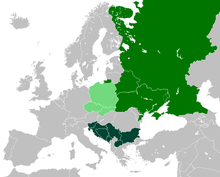West Slavs
![]()
This article or subsequent section is not sufficiently supported by evidence (e.g., anecdotal evidence). Information without sufficient evidence may be removed in the near future. Please help Wikipedia by researching the information and adding good supporting evidence.
The term West Slavs is used to refer to those Slavic peoples who until the early Middle Ages settled in the areas between the Elbe and Saale rivers in the west, the Prypiat swamps in the east, the Baltic Sea in the north and the Tisza plain in the south.
They were spatially separated from the territories of the Southern Slavs by the invasion of the Magyars into the Tisza Plain in the 10th century. The separation to the Eastern Slavs took place from the 9th century during the Christianization. Unlike the Byzantine-influenced Eastern Slavs, the Christianization of the Western Slavs took place via Roman Catholic missionaries. When describing the West Slavic settlement structures, the Latin sources use the term "Civitas", whose exact meaning in this context, however, is not fully clarified (see Civitas (Slavs)).
The West Slavs include the following ethnic groups that still exist today, each with their own languages:
- Kashubian
- Poland
- Slovaks
- Sorbs
- Czechs
In addition, there are other ethnic groups that have developed their own dialects and cultural characteristics:
- Choden
- Goralen
- Masuria
- Moravian
- Silesian
Western Slavic ethnic groups or ethnic groups that no longer exist are:

States with a majority Slavic-speaking population. Eastern Slavs Western Slavs South Slavs
See also
- Turn over
- Wendland
- Slavic Mission
- Bavarian geographer
- German colonization of the East
Search within the encyclopedia